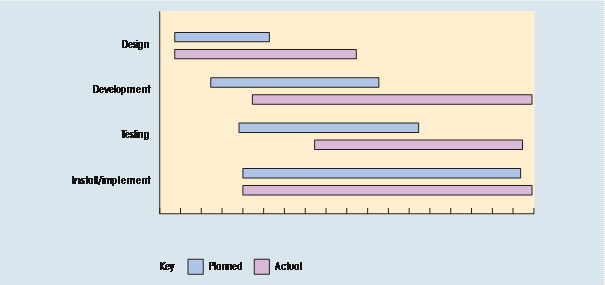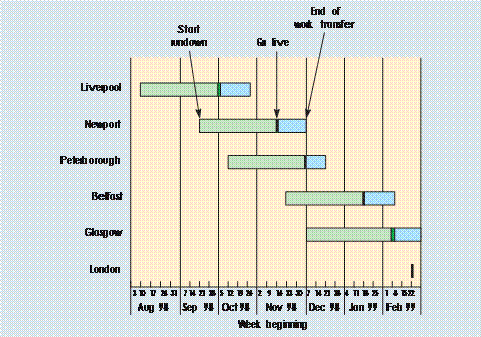Reference no: EM13946426
Case study
The Passport Office Project what should have been done differently?
The following extracts are from the National Audit Office report on the project which describes the events of the project. The case highlights many typical problems with information systems projects, which are easy to explain in retrospect, but less easy to identify in advance.
The Agency's operational imperative to start the roll-out to offices in October 1998 required all parties to deliver the new systems on time. Working to an agreed overall project plan, the contractors were each responsible for designing and testing their own systems. Apart from some initial difficulties with onsite printers in Liverpool, there were no significant difficulties with the development and implementation of the new secure printing system; the rest of this section therefore focuses on the new computer system developed by Siemens in support of the initial processing and examination of applications.
Both the design and development stages, which overlapped to some extent, took longer than expected. The design stage was completed some four months later than expected and only six months before the 'go live' date.
During the design phase, Siemens had to gain a detailed understanding of the Agency's existing processes and to put forward a solution that would meet the Agency's requirements. Discussions between the Agency and Siemens took longer than expected, as each party sought to clarify the other's intentions and to reach agreement on the system's specifications, for example to enable the system to retain electronic images of application forms, and to capture additional information from forms such as personal details of the counter-signatories appearing on passport applications. The design phase was an evolutionary process with several versions of design documents as the new system was defined and redefined by the Agency and Siemens. This process also prolonged the subsequent development.
As a result of delays at the design and development stages, testing started almost four months later than planned. Throughout the test phase, the Agency, advised by consultants from the Central Computer and Telecommunications Agency, had access to test records kept by the contractors, and representatives from the Agency witnessed most of the tests.
The first stage of factory-based testing, which involved testing the new software, took place at Siemens' testing centre in July 1998. Staff from the Agency were brought to help test the various elements of the software. Further testing, including on-site testing in Liverpool, took place in August and September. By the time the system went live in October most of the system's core functions had been delivered on schedule, although some parts of the system, for example management reports, were not fully developed. Taken as a whole, the Central Computer and Telecommunications Agency advised that the system had been well-designed. In its view, the Liverpool office should go live as a ‘controlled pilot site' although there might be a need to extend the pilot because reliability had been a problem during testing.
The Agency's internal audit service, supplied by Home Office Internal Audit, examined the introduction of the new system during September and early October and concluded that: ‘Given the tight timescales under which the project has been developed it has been well managed with sound controls in place to ensure the quality of the end products. However, there has been a compression of testing timescales'. [We] understand the compelling reasons for wanting to meet the 5 October 1998 pilot start date and acknowledge that the functionality of the [new] system was largely proven. However, the risk is that the pilot may need to have its timescales extended to ensure that robust operational and user procedures and controls are in place.
Due to time pressures, the test programme did not extend to thorough testing of the system's impact on productivity. During the factory acceptance tests conducted at Siemens' testing centre in July 1998, the Agency had become aware that the examination stage of passport processing was taking much longer under the new system. The Agency had intended to conduct further tests on productivity on-site at Liverpool in September prior to going live but, although terminals had been set aside for this to happen, the tests did not take place due to shortage of time.
The clerical procedures that would support the new system had not been tested and had not been fully documented by the time the training courses for the Agency's staff at Liverpool started in September. All Agency staff were given basic training by the Agency, together with further training specific to the role which they would be undertaking. Siemens trained the Agency's trainers and prepared the course material relating to the use of the computer system. Siemens took responsibility for training those staff who were due to transfer to it. A review of training for Agency staff, conducted by the Agency in October and based on feedback from staff, found that the courses had been well delivered and had met their objectives. However, the review had noted that the training objectives had related primarily to the use of the new computer, and less to the clerical procedures needed to support the new issuing system.
The Agency's implementation plan [Figure 2] envisaged a staged roll-out of the new system between October 1998 and February 1999, starting with Liverpool and then Newport. The Agency's aim was to install the new system before the seasonal rise in applications early in the New Year. At each office, existing computer systems would be removed; building works undertaken where necessary and office layouts re-configured, with space set aside for Siemens' staff; the new system installed and tested; and staff trained. The Agency expected each office to run down its existing workload prior to its roll-out date and transfer its incoming work to other offices that would be working normally. The aim was to maintain normal service to the public.
The roll-out at Liverpool started on time, on 5 October. The Agency's timetable left it with little time to make a final decision about the roll-out to Newport, which was due to take place on 16 November. Preparations in the Newport office, including reorganisation of the building, had begun before Liverpool started live running, and a final decision on Newport had to be taken within five weeks of Liverpool going live.
Key dates and events in the project
July 1996 Passport Agency decides to introduce the digital passport to minimise the risk of the existence of fraudulent passports, replace its existing computer system and improve its efficiency and effectiveness. This would be done through a private finance or outsourcing contract that should bring efficiency savings. April 1997 Contractors' bids received.
June 1997 Passport Agency awards 10-year PFI contract, valued at £120 million, for printing and despatching digital passports to The Stationery Office (now Security Printing & Systems Limited).


Figure 1: Tracking Gantt chart for the Passport Office project showing the original baseline plan against the actual timing
Source: National Audit Office (www.nao.gov.uk/publications/nao_reports/9899812.pdf)

Figure 2: Changeover for Passport Office Project
Source: National Audit Office; www.nao.gov.uk/publications/nao_reports/9899812.pdf
July 1997 Passport Agency awards 10-year PFI contract, valued at £120 million, to Siemens Business Services for the collection, storage and transmission of passport application data.
April 1998 Announcement made that from October 1998 children not already on a passport would require their own passports to travel abroad. Details of requirement included on new application forms distributed from this time.
5 October 1998 New IT system and outsourced procedures introduced to the Passport Agency's Liverpool Office. One hundred staff transferred to Siemens. Introduction of requirement for children to hold a separate passport if not already included on a passport.
Questions
1 Produce a detailed Gantt chart for the project similar to Figure 1, showing all the main activities and milestones referred to in the report extract and the list of key events.
2 Produce a summary of project management actions that could have been taken which may have avoided the problems experienced on the project. You should make recommendations for each stage of the systems development lifecycle and the overall project management approach.
9 November 1998 Passport Agency Management Board decides to roll-out new system and procedures to the Newport Office.
16 November 1998 New system and procedures introduced to Newport Office. 96 staff transferred to Siemens.
18 November 1998 Passport Agency Management Board decides to postpone introduction of new system to remaining four offices.
22/23 February 1999 Passport Agency Management Board decides to concentrate on prioritising applications by travel dates. Other measures agreed to boost output including additional payment to staff to increase overtime working (subsequently extended and increased).
Mid-March 1999 Home Office expresses serious concern at developing situation. Business recovery plan agreed.
May 1999 Free two-year extensions to recently expired passports offered to public queuing at Passport Offices. Virtual shutdown of telephone enquiry service at Liverpool. Transfer of work from Liverpool and Newport to other offices ceases.
Late June/early July 1999 Range of emergency measures introduced, including additional 100 staff, free passport extensions at Post Offices, special telephone helpline established.
The changeover timetable is shown in visual form in Figure 2.